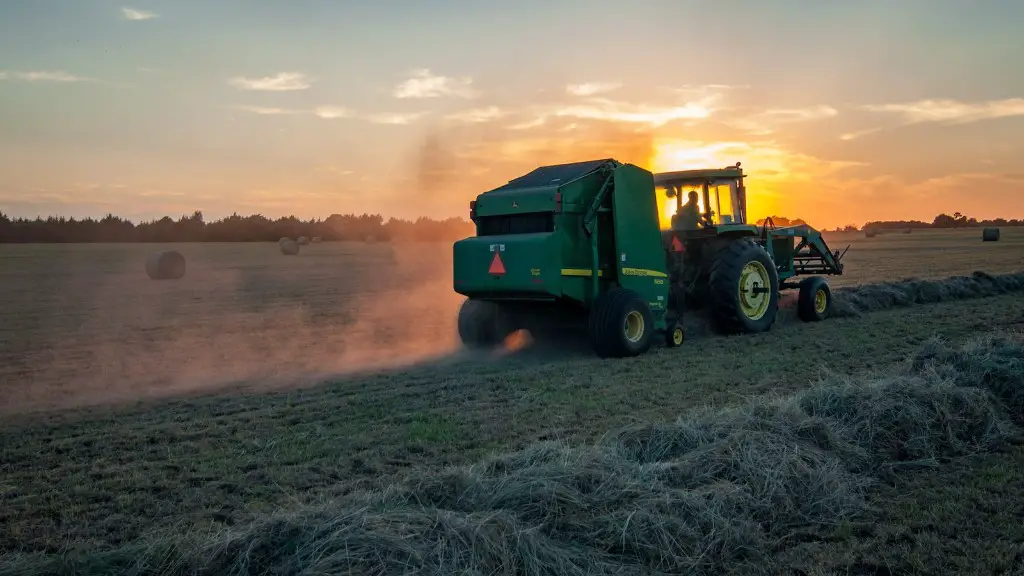A farm plan is a written document that describes your farming business. It includes your business goals, strategies, and financial information. Farm planning is an important part of running a successful farming business. It can help you make decisions about what crops to grow, how to market your products, and how to use your land.
Farm planning is the process of developing a farm business plan. It is a way to map out the future of the farm and set goals for the next 3-5 years. The farm business plan includes information on the farm’s current operations, markets, finances, and management. The plan also identifies key issues and opportunities that the farm wants to address.
What is definition of farm planning?
Farm planning is a decision making process in the farm business, which involves organization and management of limited resources to realize the specified goals continuously. Farm planning involves selecting the most profitable course of action from among all possible alternatives. The goal of farm planning is to ensure that the farm business is profitable and sustainable in the long term.
In agricultural businesses, planning is even more vital because of the inherent uncertainty associated with agricultural production. Some important sources of uncertainty include production risk, price risk, financial (or interest rate) risk, and changes in government programs.
What are the principles of farm planning
Farmstead planning is the process of designing and situating farm buildings and other infrastructure on a farm property. The goal of farmstead planning is to create a functional, efficient, and aesthetically pleasing farmstead that is well-suited to the needs of the farmer and the farm operation.
There are a number of principles that should be considered when engaging in farmstead planning. Perhaps the most important principle is to plant crops on the best soil within the farm. This will ensure that crops have the best chance of thriving and yielding a good harvest. Another important principle is to locate livestock buildings on the poorest soil within the farm. This is because livestock can be more tolerant of poor soil conditions than crops, and it can also help to prevent the spread of disease from livestock to crops.
Other important principles to consider in farmstead planning include situating buildings in easily accessible areas and avoiding slopes to prevent erosion. By following these principles, farmers can create a farmstead that is both functional and aesthetically pleasing.
Operational plans are short-term plans that focus on the day-to-day operations of a business. They detail how tasks will be completed, who will be responsible for each task, and when the task should be completed.
Strategic plans are long-term plans that identify the overall goals of a business and the steps necessary to achieve those goals.
Tactical plans are medium-term plans that detail the specific actions that need to be taken to achieve the goals laid out in the strategic plan.
Contingency plans are plans that identify what should be done in the event that something goes wrong. They are usually put in place to deal with unexpected events or problems that could arise.
What are the two types of farm planning?
A farm plan is a document that outlines the goals, management practices, and resource requirements for a farm. Farm plans are categorized into two sub- groups viz, simple farm plan and complete farm plan.
A simple farm plan implies planning for minor changes or for a particular enterprise. A complete farm planning envisages more number of changes in the existing organization.
The main difference between the two is the level of detail. A simple farm plan is less detailed and focuses on a specific enterprise or change. A complete farm plan is more comprehensive and covers all aspects of the farm business.
Planning is a critical part of achieving any goal. It allows us to see in advance what can help or hinder our progress, and makes us accountable for our actions. Without a plan, it is easy to become sidetracked or discouraged. A well-thought-out plan can make all the difference in achieving success.
What is the 5 importance of planning?
Planning involves the setting of goals and predetermined goals are accomplished with the help of managerial functions like planning, organizing, staffing, directing, and controlling Planning provides standards against which actual performance is measured.
Planning is an important step for any farm business, as it helps to identify goals and assess the farm’s strengths and weaknesses. A well-planned farm business is more likely to be successful and sustainable in the long-term.
What are the 7 principles of planning
Creating a strong plan requires focus and attention to detail. However, there are seven key principles that can make the planning process easier and more effective.
The principle of passion is key to any successful plan. Without passion, it can be difficult to maintain focus and drive.
The principle of creativity is also important. A good plan should be creative and unique, and should stand out from the competition.
The principle of influence is another crucial element. A plan should be designed to influence and engage others, and should be able to persuade them to take action.
The principle of priorities is also essential. A strong plan should be designed around a set of priorities, and should be clear about what needs to be achieved first.
The principle of flexibility is also important. A good plan should be flexible and adaptable, and should be able to change as the situation demands.
The principle of timing is also crucial. A plan should be designed to achieve its objectives within a set timeframe, and should be implemented at the right time.
Finally, the principle of teamwork is essential. A strong plan should be designed and implemented by a team of experts, and should be supported by everyone involved.
AReparing a whole-farm plan is an important step for any farm operator. By taking the time to examine all aspects of the farm business, farm families can make more informed decisions about the future of their farm.
A whole-farm plan should address a broad spectrum of components, such as family values and goals, a business analysis and business goals, a business plan, retirement plan, transition plan, estate plan, and investment plan. By taking a comprehensive approach to planning, farm families can be better prepared to make decisions about the future of their farm.
What are the 3 P’s of planning?
When developing a strategic plan, it is important to consider the 3 P’s: Purpose, People, and Process. Without a clear purpose, your organization will not be able to achieve its goals. Furthermore, it is critical to engage the right people in the process, as they will be the ones responsible for carrying out the plan. Finally, you must have a well-defined process in place to ensure that the plan is executed effectively. By taking these three factors into account, you can set your organization up for success.
Planning is an essential component of any successful endeavor. By taking the time to gather information, set objectives, devise strategies, and monitor and evaluate plan performance, you can increase your chances of achieving your goals.
What are the 3 main planning strategies
Strategic, tactical, and operational planning are all important tools that managers can use to help achieve their organization’s goals. Operational plans lead to the achievement of tactical plans, which in turn lead to the attainment of strategic plans. By carefully crafting and implementing plans at all levels, managers can increase the chances of success for their organization.
The efficient utilization of all the available resources on the farm is the key to a successful farming operation. The family and hired human labor should be appropriately distributed to ensure more yield from farm enterprise. Enough power and machinery should be kept on the farm to do work timely.
How many types of farm planning are there?
A farm’s planning is important in order to decide what the farm’s goals should be for the upcoming year or years. Without a plan, it can be difficult to know what needs to be done in order to achieve success. There are two types of farm planning – annual and long range.
Annual planning is for the upcoming agriculture year and usually entails more immediate goals. Long range planning, on the other hand, covers a longer period of time – typically 5 to 10 years – and involves more long-term objectives.
Both types of farm planning are important in order to ensure the success of the farm. Without a plan, it can be difficult to know what needs to be done and when, which can lead to problems down the road.
There are three types of planning that can be used in order to determine what a farm or agricultural business will do: isolated, integrated, and comprehensive.
Isolated planning is when each aspect of the business is planned out separately from the others. So, the crop plan would be made without considering the livestock, and vice versa. This type of planning can work if the businesses are small and there is not a lot of interaction between the different aspects.
Integrated planning is when the different aspects of the business are planned out together, taking into account how they will all work together. For example, in a crop and livestock operation, the acres planted and the number of animals to be raised would be planned together in order to ensure that there is enough feed for the livestock. This type of planning is more common in larger businesses where there is more of a need to consider how the different aspects will impact each other.
Comprehensive planning is the most advanced form of planning, and is also known as total planning. This type of planning takes into account all aspects of the business, as well as the external factors that could impact the business. For example, in addition to considering the crop and livestock operation, comprehensive planning would also consider things like the price
Why is planning important 3 reasons
Planning is an important part of goal setting and achieving success. By planning ahead, you can ensure that your goals are realistic and that you have a clear path to achieving them. Planning also allows you to make decisions about how to best achieve your goals and to set a timeframe for doing so. Additionally, planning helps you to measure your progress against your goals and to assign responsibility for achieving them.
Tactical planning is a process that is used to identify the specific actions that need to be taken in order to achieve the goals and objectives that were identified in the strategic planning process.
Operational planning is a process that is used to identify the resources that will be required to achieve the goals and objectives that were identified in the strategic and tactical planning processes.
Contingency planning is a process that is used to identify the actions that need to be taken in response to unexpected events.
Warp Up
Farm planning is the process of mapping out what you want to do with your farm and when you want to do it. This planning process can be applied to any size farm, from a hobby farm up to a large commercial operation. It can help you make decisions about what crops to grow, how to allocate your land and other resources, and what type of farm equipment you need.
Farm planning is a process of creating a farm plan that sets forth the goals, objectives, and strategies for running a farm. It involves assessing the farm’s current state, developing a vision for the future, and creating a plan to get there. Farm planning can help farmers make better decisions about their farm business, improve their operations, and achieve their goals.





